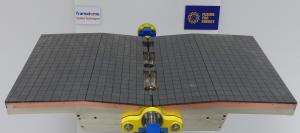Qualification program concludes in Europe
Directly facing the heat and high-energy neutrons produced during fusion is the first wall of the ITER blanket—440 beryllium-coated, detachable panels that will be installed on the inboard and outboard surfaces of the vacuum vessel over a surface of 610 m². The European agency for ITER, Fusion for Energy, has reached the end of its industrial qualification program for the panels that are under its responsibility.
The ITER blanket system provides the physical boundary for the plasma and contributes to the thermal and nuclear shielding of the vacuum vessel and the external machine components such as the superconducting magnets operating in the range of 4 Kelvin (-269 °C). Directly facing the ultra-hot plasma and having to cope with large electromagnetic forces, while interacting with major systems and other components, the blanket is among the most critical and technically challenging components in ITER.
Each of the 440 plasma-facing first wall panels of the ITER blanket measures 1 x 1.5 metres (height x length), and is coated with a 6- to 10-millimetre layer of beryllium armour tiles bonded to a copper alloy heat sink mounted on a stainless steel structure.
Half of the panels are under the procurement responsibility of the European Domestic Agency, Fusion for Energy: 215 normal heat flux first wall panels designed for heat fluxes of up to 2 MW/m². (China and Russia are sharing the procurement of 225 enhanced heat flux panels designed for 4.7 MW/m².) For all parties, first wall design, development and qualification is progressing in phases, including the manufacture and testing of small-scale mockups, followed by semi-prototypes, and finally full-scale prototypes that open the way to series production.
In Europe, the last phase of the industrial qualification program is drawing to a close. Contracts awarded for three full-scale prototypes have been executed and quality tests are underway on the results. The choice of awarding the contracts for full-scale prototypes to three companies—Atmostat, Framatome and the consortium Iberdrola/Woods/Leading—was made by the European Domestic Agency to mitigate risk on these technically challenging components and preserve competition up to series production. The next step for the European agency is the call-for-tender for the production of the first wall panels.
"The manufacturing completion of these three full-scale "normal heat flux" first wall prototypes by the suppliers of the European Domestic Agency is the culmination of many years of effort with strong Domestic Agency/ITER Organization collaboration; it represents a major milestone in our first wall procurement activities," comments René Raffray, leader of the ITER Blanket Section. "Congratulations to our colleagues from Fusion for Energy and their suppliers involved in this successful endeavour."
Qualification programs are also advancing in Russia and China, where full-scale prototype programs for the enhanced heat flux panels will be launched in 2020.
See the full story, with photos, on the Fusion for Energy website.


